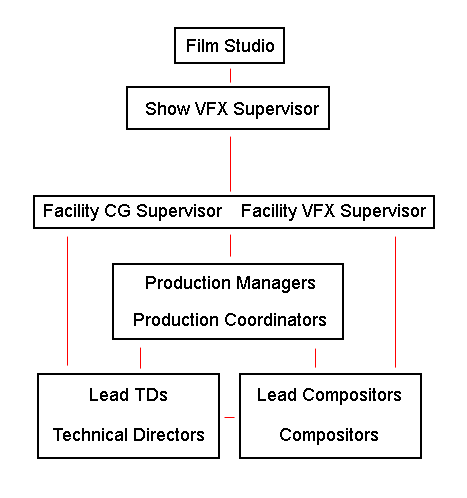The Hierarchy of VFX Production
I was talking on IM with an interested party in India, and he was wondering what sort of barking order happens in the film visual effects industry. Here's something I created to illustrate this hierarchy.
At the top of the food chain likes the film studio. This studio is responsible for greenlighting a film, hiring directors for their picture, and usually is the ultimate authority on how the picture ends up and where it goes. An example of a film studio include New Line Cinema, Warner Brothers, and Dreamworks SKG.
The film now contains several top level artists, which are the director and the visual effects supervisor for the film. Sometimes they are hired at the same time by the studio, and sometimes the director likes a particular vfx supervisor and will recommend the studio to hire this person because they work well together. An example of a visual effects supervisor would be Michael Fink, Dennis Muren, or John Gaeta.
During this process, vfx studios bid out sequences of the film. This bid can contain how long it takes to accomplish a particular effect, R&D for certain effects, and how much all of this will cost. These visual effects studios include, but are not limited to, the likes of ILM, Digital Domain, Tippett, The Orphanage, and so forth. Once a show has been awarded by the film studio to a vfx studio, the vfx studio must now choose an internal vfx supervisor to lead the team at this facility. Examples of a vfx supervisor at a dedicated facility include, Craig Hayes, Joel Hynek, and Colin Strause. Depending on the complexity of the show, a CG supervisor will also be choosen. This person is responsible for the technical aspect of the visual effects, which can comprise of Renderman shaders written for the show, lighting tools to make the artists' live easier, and so forth. Sometimes the CG and VFX supervisor are the same person, sometimes they're not. Again, it depends on the show.
The visual effects supervisor has a team of people with him, which is the visual effects production team. This team includes Production Managers and Production Coordinators. These people are responsible for keeping everyone working on time, making sure nothing goes overbudget, asking for more money when necessary, and keeping the artists happy and productive. Without a good production team, the production can go haywire. Shots can go long without being worked on, and in the end, artists could be forced to work more than five days a week. For shame.
Below this group is the one I belong to, the Comp group. As well, there's another group at the same level, the TD group. Also, depending on the production, there's the Animation and FX group, and sometimes a Roto group. All of us on the same level usually work amongst ourselves, talking with other artists from other groups and generally trying to make the best visual effects that we can for the groups above! The Production Coordinators manage our shots and the time we have for them, and the production manager manages everything in visual effects production! You can see that we often connect directly with the visual effects supervisor. This often happens near a deadline or when a critical look has to be established for the film. He'll come by, take a look, and point us on our merry way.
For approvals, the process is reversed. I create a shot, the lead comper of the show approves that, and then it goes up the chain. Our visual effects supervisor, the show vfx supervisor, and then the director, and then the studio. If everyone's happy, we have a final shot, and we film it out or do what we have to do to make sure Production gets the shot in their hands, and it goes to their Editorial department, which cuts the show up for broadcast.
Hopefully this answers some nagging questions you may have, or maybe it opens up more! As always, I'm ready to hear feedback.


Leave a comment